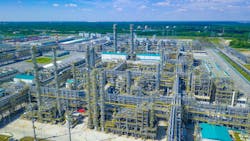Sibur’s ZapSibneftekhim upgrading unit at Tobolsk petrochemical complex
PJSC Sibur Holding subsidiary OOO ZapSibNeftekhim has let a contract to Honeywell UOP LLC for the modernization of a propane dehydrogenation (PDH) unit to increase propylene feedstock for expanded production of polypropylene at its 2.5-million tonnes/year (tpy) base polymers petrochemical complex located 10 km east of Tobolsk, in Western Siberia’s Tyumen region (OGJ Online, Feb. 20, 2015).
As part of the contract, UOP will deliver licensing of its proprietary C3 Oleflex technology, as well as basic engineering design, equipment, catalysts, adsorbents, and other unidentified services for the PDH unit revamp, which will enable the unit to boost production of propylene by 8% to 561,000 tpy to help meet Russia’s growing demand for propylene derivates, the service provider said on Aug. 4.
While UOP did not reveal a value of the contract or a timeframe for the project’s implementation, ZapSibNeftekhim said in a separate late-July release that detailed design for the revamp already is under way, with construction and installation works scheduled to begin this November.
“The project for the modernization of the [PDH] unit includes 12 subprojects, [five of which] are associated with the replacement of equipment, [and] another seven with installation of additional technological units,” said Ramil Ryabikov, ZapSibNeftekhim’s director of the Tobolsk complex’s monomer production plant.
With direct connection of new equipment slated to take place during a planned maintenance at the site scheduled for spring-summer 2022, the revamped unit should be operational by yearend 2022, according to ZapSibNeftekhim.
Modernization
Alongside reducing production costs, energy consumption, and overall emissions at the complex, the PDH unit modernization also will include a fully recyclable platinum and alumina catalyst system to help further minimize the site’s environmental footprint. Other works planned as part of the revamp project include installation of new gas purification units, replacement of old torch burners with modern ones that consume less fuel, and other equipment upgrades that will enable longer intervals between regularly scheduled maintenance shutdowns to limit unit downtime, ZapSibNeftekhim said.
The operator’s decision to advance modernization of the 510,000-tpy PDH unit—which was commissioned in 2013 as part of then-operator OOO Sibur Tobolsk’s first 500,000-tpy polypropylene production plant—comes amid a shortfall in propylene feedstock supply at the site, which has required the company to partially increase imported volumes to maintain the complex’s polymer production capacities, according to Maxim Rogov, ZapSibNeftekhim’s general director.
“[Modernization of the PDH] plant [will] improve [its] performance, reliability, and operational efficiency [and] allow the complex to increase the share of its own [propylene feedstock] for production of [polypropylene and other olefins, the global market for which] is growing at 3-4% [annually],” Rogov said.
In addition to its 1-million tpy polypropylene production, ZapSibNeftekhim’s Tobolsk petrochemical complex—Russia’s largest—produces 1.5 million tpy of polyethylene, as well as a mix of byproducts that include butadiene, butene-1, methyl tertiary butyl ether, and pyrobenzene, according to the operator.
About the Author
Robert Brelsford
Downstream Editor
Robert Brelsford joined Oil & Gas Journal in October 2013 as downstream technology editor after 8 years as a crude oil price and news reporter on spot crude transactions at the US Gulf Coast, West Coast, Canadian, and Latin American markets. He holds a BA (2000) in English from Rice University and an MS (2003) in education and social policy from Northwestern University.

